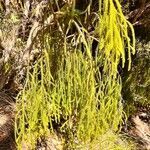Tree up to 35m., rarely up to 60m., trunk up to 1·5m. or more diam., bark dark brown, scaling off in thick flakes, wood dark red; branchlets slender, pend. Lvs imbricate, of juveniles 4-7 mm. or more long, 0·5-1 mm. wide, keeled, acute, linear-subulate, subfalcate, de-current; of semi-juveniles (often flowering and fruiting in this stage) ascending, incurved, c. 4 mm. long, rhomboid; of adults more appressed, 2-3 mm. long, rigid, subacute, subtrigonous. Male strobili solitary or paired, terminal 0·5-1 cm. long; apiculus ovate-acuminate. Ovules solitary, terminal on curved branchlets, ultimate lvs forming a swollen, red, succulent receptacle, or rarely dry. Carpidium embracing lower part of seed, which is about 4 mm. long, oblong-ovoid or narrow-ovoid, little compressed.
More
A tree. In cultivation it is about 9 m high. It can grow 27-60 m high. It turns reddish brown in winter. Adult trees have shorter, fleshier needles than juvenile ones. Trees are separately male and female. Male cones are small. Female trees bear small bluish seeds. Each seed is sunk in a bright red fleshy cup.


